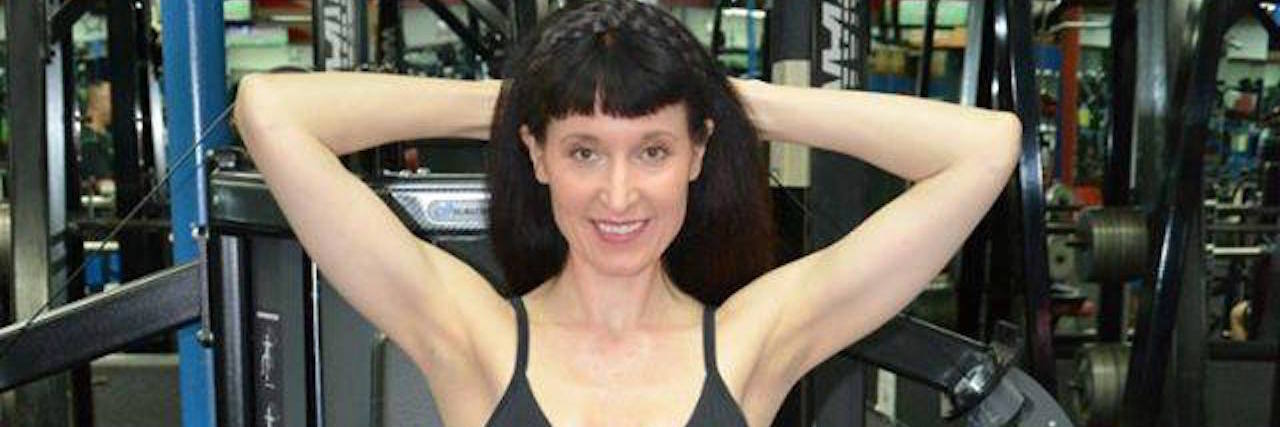I am 45 and have been living with a rare primary immune deficiency disease called hypogammaglobulinemia my whole life. I get weekly infusions of antibodies made from donated blood plasma to give me a temporary immune system. I also have a rare skin condition called porokeratosis, which can be pre-cancerous, so I am not supposed to spend time outdoors before 4 p.m. and I must religiously protect my skin. I also have been diagnosed with hypocomplementcemia, spondylolisthesis, lower back pain and disk disease, migraines, gastroesophageal reflux disease, mitral valve prolapse, and tendinitis – which is most likely a side effect of a prescription drug I took to fight infection. Some of these are part of the immune deficiency package.
Things like fatigue, back pain, headaches and nausea are just some of the symptoms and side effects. And I am an excellent responder to my treatment. To say I don’t always feel well is probably a understatement. I had my primary disease my whole life, so to me it’s normal.
When I was younger, and before diagnosis, I thought I was normal and that everyone else must be sick all the time too. Silly, I know, but how was I really supposed to know what normal was if I never experienced it?
I was almost always active. I started dancing school when I was 3 years old and attended until I was 13, even though on a few occasions I collapsed from infection. In my early 20s I took up running and weight lifting, despite living with a host of debilitating symptoms doctors did not yet understand. Over the years and as my diagnoses added up, I have had to modify my workouts, and that is one of the things this article is about.
Unless you live under a rock, you will see workouts everywhere. And if you have health conditions you may not be able to do most of them. For many people that doesn’t mean you can’t do any exercises. Most people could benefit from a workout program. I believe that modern medicine, if combined with good nutrition and fitness, along with spiritual and mental health, can produce the best outcome. It’s never a cure unless your illness is caused by lifestyle, but good self-care can help you do your best with your diagnosis. Here are some of my tips and ideas I hope will help if you are considering improving your fitness.
1. Work with professionals. Get a proper diagnosis and follow the advise of your doctor. See a physical therapist, and when ready, get a personal trainer if you need to figure out how to work out safely.
2. Go at your own pace. The only race you are in is with yourself. With fitness, sometimes it’s the turtles that win the race anyway. By working out slowly and easily, you may work out into later years that high intensity types who may experience more injuries.
3. Only do what is comfortable. I never do any exercise that hurts. The only exception to this rule is when in physical therapy. Some times there will be some pain before you get better, but a good therapist knows good pain from bad pain.
4. Can’t jump, or run? Who cares. Focus on what you can do today. What you used to do is another comparison to avoid. I used to be able to do many things I can’t anymore, but that doesn’t mean there aren’t plenty of things I can still do today.
5. Keep it fun. A workout you like is one you will do long and often, and enough for it to benefit you.
6. You don’t have to be a morning person or be at the gym every day. My workouts are one hour a week and when I feel up to it – which is never in the morning!
7. You don’t have to break a sweat. I don’t sweat when I do my workouts. Most are seated exercises that I have become used to so they are just maintenance. I don’t plan on being in any Olympics any time soon, so maintaining my muscle is good enough. If a program is new it may be challenging, and if you wish to keep increasing your strength and endurance, that is great – but not every workout needs to be overly difficult. Some studies have shown that intense endurance exercise like running a marathon may actually lower the immune system.
8. Massage therapy and chiropractic care can help you manage pain and keep you active. If your insurance covers it – give it a try.
9. Good nutrition can pick up where exercising leaves off. Many insurance plans will cover a visit with a nutritionist to help you figure out a healthy diet for your conditions and medications you are taking. Don’t try fad diets, most are very unhealthy.
10. Getting in shape is not about achieving physical perfection. It’s just about feeling your best for what you are going through. Some studies I have read have shown that slightly overweight people who exercised were healthier than sedentary thinner people. So long as you can breath and your heart is up to it, movement is good for most bodies.
11. Don’t take supplements without speaking with your doctors. Some may interact with your medications or worsen a condition. Always list your vitamins and supplements along with the medications you are taking when asked about your medications.
12. Drink plenty of water and get plenty of rest. This applies to healthy people too but especially those with chronic illness.
We want to hear your story. Become a Mighty contributor here.

